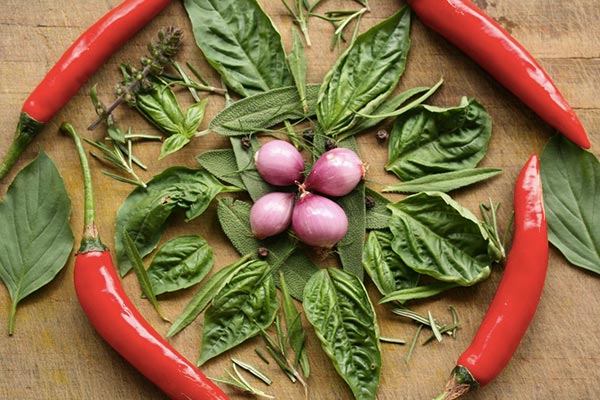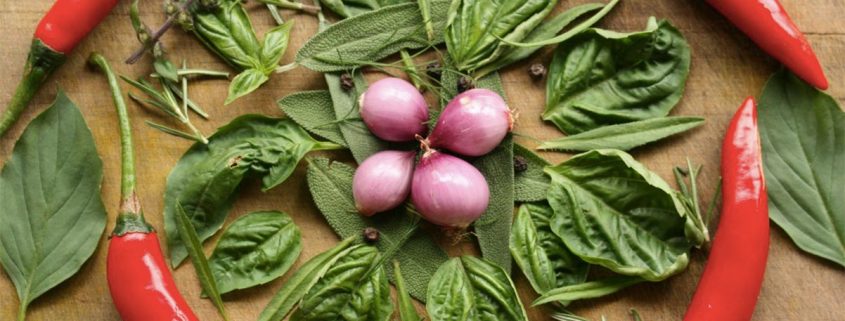Herbs and Spices
 Herbs and spices. What’s the difference?
Herbs and spices. What’s the difference?
Herbs: aromatic leaves of plants and trees.
Spices: aromatic roots, bark and berries and seeds.
Feel free to argue.
Dry or fresh: Usually determined by use. Fresh is often, but certainly not always best.
- I prefer dried oregano for baking because the dried flavour is earthy and intense.
- I don’t see the point of drying basil, all that aromatic, peppery perfume goes out of the window leaving something akin to dried grass.
Pepper is a glorious spice. Back in the 1600’s, when the Dutch ‘East Indian Company’ came back to Holland with the first batch of peppercorns the stuff was wildly popular and only available to the wealthy. To this day, when referring to something expensive, people in Holland say ‘peper duur’ literally, ‘pepper expensive’, despite the fact that pepper is a very affordable spice these days. Yes, pepper is a delicious spice and well suited to certain dishes and ideally used freshly roasted, coarsely ground, and added last minute so that it’s pungent aroma compliments strong flavoured foods. Think animal protein such as grilled beef or tuna, pan fried mushrooms, roasted tomatoes, pumpkin, etc.
Some restaurants have shakers with old, aroma-less finely ground powder which is supposed to resemble pepper on the tables. Certain people, when being served their chosen dish will then completely mindlessly, without examining their food first, reach for the salt and pepper shaker and dust their well earned meal. Nod your head if this is you. I doubt you have any reason for doing this other than an unconscious behavioral patterns copied from your parents. If this article makes you more pepper conscious, then an army of chefs who carefully season your food and want you to truly taste it, will be thankful. Now that I’ve unleashed my chef’s pride, I’d like to cheer up and share a few more fun ways with herbs and spices that you may or may not be familiar with.
To stick with pepper, try this Italian inspired dish. Place a cup of balsamic vinegar in a sauce pan and reduce it on low heat into a thick, sweet and sour syrup, allow to cool. Place an array of fresh strawberries on a plate. Drizzle with your balsamic syrup and grind black pepper over the top. Optional, rip of few basil leaves into pieces and sprinkle to finish off the dish.
I’m in love with sage, and it grows really well in Bali. Heat a thick layer of oil in a small saucepan to about 170 degrees. You’ll know it’s the right temperature when you drop in a clean, dry sage leave, it should crisp up and stop bubbling in under 15 seconds. When crisp, lift sage leaves from the oil onto a tissue. Allow to cool before storing in a airtight jar. Use these flavoursome crispies as a low carb crouton on your salad or a fancy decoration next time you’d like to impress your lover.
Another spice hero, cinnamon. In the west it’s often used in sweet pastries whilst in Asia you’ll find the bark of this tree in fragrant curries. Look for real cinnamon; in some countries it’s called continental or Dutch cinnamon, a thin, straw like piece of bark. If it’s thick you might be dealing with its cousin cassia which is not as fine in aroma. If you have a coffee grinder you can grind it yourself at home. I like using very small amounts of cinnamon to give a mysterious background aroma that people can’t place. It’s best used in this way in sweet tasting yet savory dishes. Sprinkle a little onto pumpkin before roasting. A tiny piece of bark bubbling along in your sweet corn chowder or red wine sauce might have people begging for your secret.
Herb Mania
When it comes to fresh herbs, go wild! In the middle east they’ve got herb attitude, such as Tabouleh; a salad with its main ingredient being flat leaf parsley. To eat parsley as a salad might take getting used to for some but once you start it’s addictive! You’ll also benefit from its many potent health benefits, a natural breath freshener being one of them. A big ‘No’ to 1 sprig of parsley in your vegetable soup. Fresh herbs in soup are great but only add them just before serving otherwise their aroma will be lost. Tough stemmed herbs like rosemary and thyme are an exception to this and can be added a little earlier in the cooking process.
Don’t hold back:
- Half a bunch of roughly chopped coriander to finish off a carrot and coconut soup.
- A handful of mint leaves thrown into a chickpea salad.
- A crazy mixture of dill, mint, coriander and parsley in your Vietnamese rice paper rolls.
That’s how we roll in fresh herb country!
Grow or buy? Needless to say, any self respecting fresh herb guru grows their own. Imagine unlimited access to fresh herb heaven. If you have a small patch of land, or even a window sill, grow it! Parsley, coriander, mint, basil are a good start.
- well drained soil, sunshine, and water
- a bit of composted manure
- lots of love
They will grow for a couple of months, start flowering (give them regular haircuts) and begin to diminish after a year. Every couple of months plant more seeds for continuous crops. The flowers make great edible decoration. Coriander flowers will soon produce delicious seeds which can be used in all sorts of dishes.
A Mediterranean style herb garden, with rosemary, sage, lavender and thyme will do well with well drained sandy soil and not as much fertilizer. These bushy herbs will stick around for many years and are all great for casseroles and slow roasted meals.




